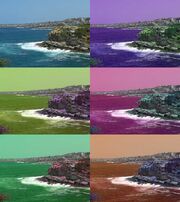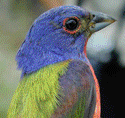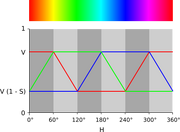Assessment |
Biopsychology |
Comparative |
Cognitive |
Developmental |
Language |
Individual differences |
Personality |
Philosophy |
Social |
Methods |
Statistics |
Clinical |
Educational |
Industrial |
Professional items |
World psychology |
Biological: Behavioural genetics · Evolutionary psychology · Neuroanatomy · Neurochemistry · Neuroendocrinology · Neuroscience · Psychoneuroimmunology · Physiological Psychology · Psychopharmacology (Index, Outline)


An image with the hues cyclically shifted in HSL space.

The hues in the image of this Painted Bunting are cyclically rotated with time.
Hue is one of the main properties of a color, defined technically (in the CIECAM02 model), as “the degree to which a stimulus can be described as similar to or different from stimuli that are described as red, green, blue, and yellow,”[1] (the unique hues). The other main correlates of color appearance are chroma, saturation, lightness, and brightness.
Usually, colors with the same hue are distinguished with adjectives referring to their lightness and/or chroma, such as with "light blue", "pastel blue", "vivid blue". Exceptions include brown, which is a dark orange,[2] and pink, a light red with reduced chroma.
In painting color theory, a hue refers to a pure color—one without tint or shade (added white or black pigment, respectively).[3]. A hue is an element of the color wheel. Hues are first processed in the brain in areas in the extended V4 called globs.[4][5]
Computing hue[]
In opponent color spaces in which two of the axes are perceptually orthogonal to lightness, such as CIE L*a*b* (CIELAB) and CIE L*u*v* (CIELUV), hue may be computed together with chroma by converting these coordinates from rectangular form to polar form. Hue is the angular component of the polar representation, while chroma is the radial component.
Specifically, in CIELAB:[6]
while, analogously, in CIELUV:[6]
In practice, a four-quadrant arctangent may be used if available to invert these formulae.
Computing hue from RGB[]
Preucil[7] describes a color hexagon, similar to a trilinear plot described by Evans, Hanson, and Brewer,[8] which may be used to compute hue from RGB. To place red at 0°, green at 120°, and blue at 240°, one may solve:
He also used a polar plot, which he termed a color circle.[7] Using R, G, and B, rather than the R, G, and B densities Preucil used, one may compute hue angle using the following scheme: determine which of the six possible orderings of R, G, and B prevail, then apply the appropriate formula; see table below.
HSV color space as a conical object

An illustration of the relationship between the “hue” of colors with maximal saturation in HSV and HSL with their corresponding RGB coordinates.
| Ordering | Hue Region | Formula |
|---|---|---|
| Red-Yellow | ||
| Yellow-Green | ||
| Green-Cyan | ||
| Cyan-Blue | ||
| Blue-Magenta | ||
| Magenta-Red |
Note that in each case the formula contains the fraction , where H is the highest of R, G, and B; L is the lowest, and M is the mid one between the other two. This is referred to as the Preucil Hue Error, and was used in the computation of mask strength in photomechanical color reproduction.[9]
Hue angles computed for the Preucil circle agree with the hue angle computed for the Preucil Hexagon at integer multiples of 30 degrees (red, yellow, green, cyan, blue, magenta, and the colors mid-way between contiguous pairs), and differ by approximately 1.2 degrees at odd integer multiples of 15 degrees (based on the circle formula), the maximum divergence between the two.
The process of converting an RGB color into an HSL color space or HSV color space is usually based on a 6-piece piecewise mapping, treating the HSV cone as a hexacone, or the HSL double cone as a double hexacone.[10] The formulae used are those in the table above.
Hue vs. dominant wavelength[]
Dominant wavelength (or sometimes equivalent wavelength) is a physical analog to the perceptual attribute hue. On a chromaticity diagram, a line is drawn from a white point through the coordinates of the color in question, until it intersects the spectral locus. The wavelength at which the line intersects the spectrum locus is identified as the color's dominant wavelength if the point is on the same side of the white point as the spectral locus, and as the color's complementary wavelength if the point is on the opposite side.[11]
Hue difference: or ?[]
There are two main ways in which hue difference is quantified. The first is the simple difference between the two hue angles. The symbol for this expression of hue difference is in CIELAB and in CIELUV. The other is computed as the residual total color difference after Lightness and Chroma differences have been accounted for; its symbol is in CIELAB and in CIELUV.
See also[]
- Colorfulness
- Chromaticity
- Color saturation
- Invariant hues
- Lightness (color)
- Munsell color system
- Bezold-Brücke shift
References[]
- ↑ Mark Fairchild, “Color Appearance Models: CIECAM02 and Beyond.” Tutorial slides for IS&T/SID 12th Color Imaging Conference.
- ↑ C J Bartleson, "Brown". Color Research and Application, 1 : 4, p 181-191 (1976).
- ↑ http://creativecurio.com/2008/05/the-color-wheel-and-color-theory/
- ↑ Conway BR, Moeller S, Tsao DY. (2007). Specialized color modules in macaque extrastriate cortex. Neuron. 56(3):560-73. PMID 17988638
- ↑ Conway BR, Tsao DY. (2009). Color-tuned neurons are spatially clustered according to color preference within alert macaque posterior inferior temporal cortex. Proc Natl Acad Sci U S A. 106:18035-18039. PMID 19805195
- ↑ 6.0 6.1 Colorimetry, second edition: CIE Publication 15.2. Vienna: Bureau Central of the CIE, 1986.
- ↑ 7.0 7.1 Frank Preucil, "Color Hue and Ink Transfer … Their Relation to Perfect Reproduction, TAGA Proceedings, p 102-110 (1953).
- ↑ Ralph Merrill Evans, W T Hanson, and W Lyle Brewer, Principles of Color Photography. New York: Wiley, 1953
- ↑ Miles Southworth, Color Separation Techniques, second edition. Livonia, New York: Graphic Arts Publishing, 1979
- ↑ Max K. Agoston (2004). Computer Graphics and Geometric Modelling v. 1: Implementation and Algorithms, 301–304, Springer.
- ↑ Deane B Judd and Günter Wyszecki, Color in Business, Science, and Industry. New York: Wiley, 1976.
External links[]
| This page uses Creative Commons Licensed content from Wikipedia (view authors). |





















